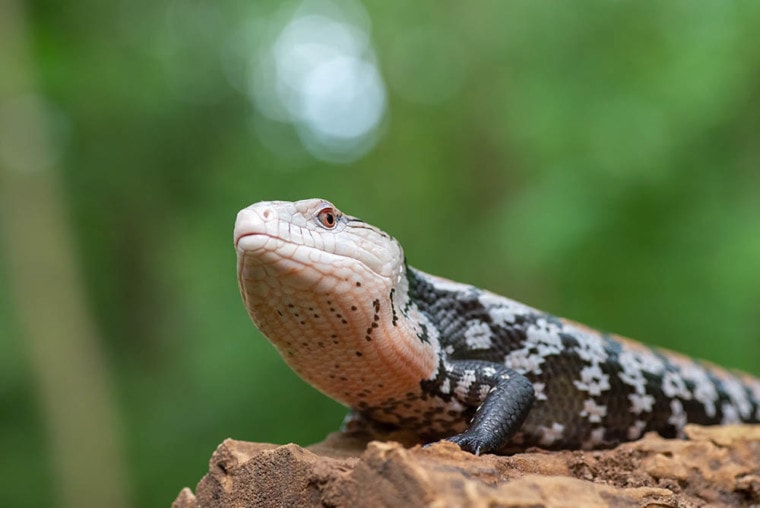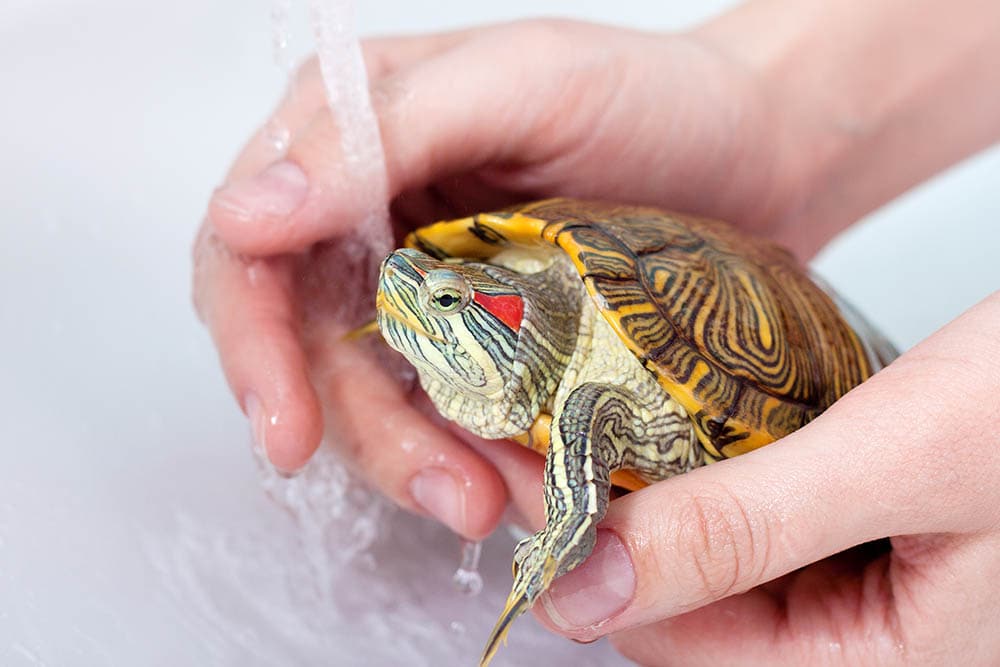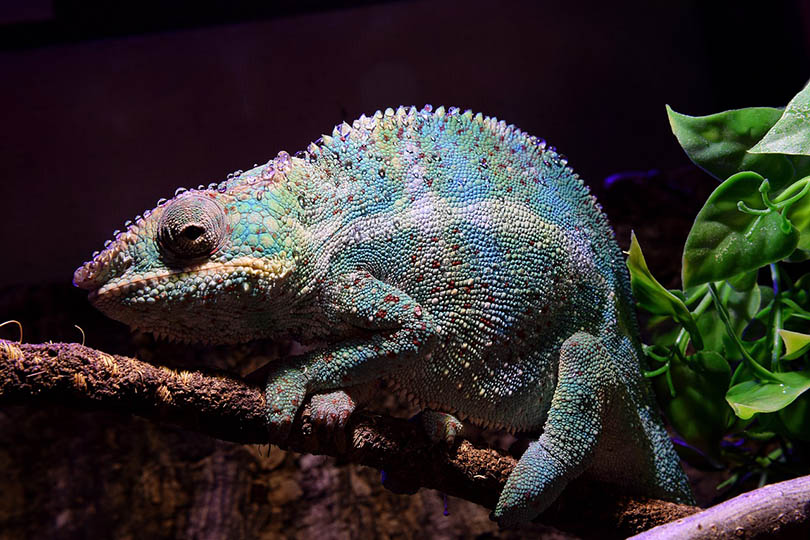
Found in the grasslands and woodlands of Australia, the northern blue-tongued skink is one of the two most common of the blue-tongued skink subspecies. They can also be found in New Guinea and Indonesia. This species has small legs and feet and a bright blue tongue that is usually shown as a means of warding off potential predators.
These unusual omnivores have a diet consisting of approximately 50% greens with the remainder made up of insects and some fresh fruit. Although they are large and, as such, require a large enclosure with plenty of room, they generally make friendly and approachable lizard pets.
Quick Facts about Northern Blue-Tongued Skink
| Species Name: | Tiliqua scincoides intermedia |
| Common Name: | Northern Blue-Tongued Skink |
| Care Level: | Moderate |
| Lifespan: | 20 years |
| Adult Size: | 18” – 24” |
| Diet: | Greens, insects, fruit |
| Minimum Tank Size: | 50 gallon |
| Temperature & Humidity: | 70°F – 100°F temperature
50% humidity |
Do Northern Blue-Tongued Skinks Make Good Pets?
The northern blue-tongued skink is the largest skink species and you should expect a lizard that will grow to around 2 feet in length. As such, it requires a sizeable tank, with an adult requiring at least a 50-gallon enclosure.
You also need to ensure heating ranges from 70°F to 100°F and that you can maintain humidity at approximately 50%.
Finally, the lizard requires live food, insects in this case. However, it is considered gentle, friendly, approachable, and of decent intelligence for a lizard pet. Therefore, while it does require a little more effort than some species, the northern blue-tongued skink makes a good pet.

Appearance
Including the tail, the northern skink will reach a length of approximately 24 inches. It has a large head compared to its body, short legs, and small feet. It has the appearance of a short snake with a head and small feet. Their most obvious feature is their blue tongue. There is some debate over the range of uses for this tongue, but it is known to act as a deterrent to predators, and some experts believe it is used as a means of communicating with other blue-tongued skinks.
How to Take Care of Northern Blue-Tongued Skinks
You will need to ensure that your skink has enough space and that it has everything it needs for a happy and healthy life.
Tank
Although it is possible to keep a juvenile in a 25-gallon tank, it will soon outgrow this and require a larger enclosure. Adults need an absolute minimum of a 40-gallon tank, but you should consider the space inside a 55-gallon tank to be minimum.
The exact dimensions may differ but will be around 48” x 13” x 21” which enables you to achieve the appropriate heating gradient across the enclosure.
If you have a juvenile, you can fill a large tank with decorations and gradually remove them until your adult skink is left with more open space.
You will need to spot clean the tank every day, and remove and disinfect everything every month, to ensure that the tank is kept clean and sanitary.
Lighting
This basking lizard requires a UVB light source. Use a 10% UV tube and mount it to the top of the cage. If you can place it near the back of the cage, this will give a good light gradient so that your lizard can get into and out of the UV light as required.
Heating (Temperature & Humidity)
In the wild, the northern blue-tongued skink would spend a lot of time basking. Provide a basking area with a temperature of up to 100°F, with the cooler side of the tank at 80°F. Leave the basking lamp on 12 hours a day. Humidity needs to be between 40% and 60%: aim for a 50% humidity level, which allows a rise or drop of a few percent.
Substrate
You can use a sand/soil mix or offer woodchip. The enclosure will also need decoration. Offer hiding spots, wood decorations, rocks, slate, caves, cork pieces, and other decorations that provide shade.
| Tank Recommendations | |
| Tank Type: | 55 gallon glass vivarium |
| Lighting: | Basking lamp plus UVB tube |
| Heating: | Heating lamp and basking lamp |
| Best Substrate: | Woodchip |
Feeding Your Northern Blue-Tongued Skink
The Northern Blue-Tongued Skink will consist of around 50% greens, 45% insects, and 5% fruit to be given as treats.
Insects should be gut-loaded before being fed because this ensures optimal nutrition and protein levels. Insects can include brown crickets, black crickets, and locusts. You can treat them with waxworms or mealworms, and some owners also provide a regular but not too frequent protein source like a thawed pinkie. Greens, such as kale, as well as carrot and other vegetables make up the salad element of the lizard’s diet, and you can add roughage like dandelions a couple of times a week.
Although it will probably never drink from it, provide a water bowl in your skink’s enclosure.
| Diet Summary | |
| Fruits: | 5% of diet |
| Vegetables: | 40% of diet |
| Insects: | 50% of diet |
| Meat: | 5% of diet – small/medium-sized rodents |
| Supplements Required: | Calcium and vitamin D3 supplementation |
Keeping Your Northern Blue-Tongued Skink Healthy
Although generally very hardy, northern blue-tongued skinks are prone to a number of illnesses and health complaints. The most common problems are caused by poor living conditions or poor enclosure maintenance.
Common Health Issues
Lifespan
The blue-tongued skink will usually live for around 20 years, but with good care and if it avoids common illnesses, your skink may live as long as 30 years in captivity.
Breeding
Northern blue-tongued skinks will breed naturally so you do not need any special preparation other than to house a breeding pair together. They give birth to live young and babies will need to separate them from their parents early, so make sure you have a vivarium ready for any little ones that are born. These ovoviviparous lizards have a gestation period of approximately 100 days and reach sexual maturity at approximately 2 years. A litter usually consists of between 4 and 6 baby lizards.
Are Northern Blue-Tongued Skinks Friendly? Our Handling Advice
Allow your new skink 7 to 10 days to settle into its new tank and get used to its new surroundings. You can talk to the lizard during this time, and continue to do so. When you start gradually introducing your hand, try to do so in the tank or somewhere that the skink cannot get away. Keep talking and after an initial attempt to hide, your lizard will come to investigate. Try this every day. It might take a week or longer but the skink will eventually come to you of its own volition.
Take the skink out for five minutes a day at first, and increase this very gradually over time. The skink is usually quite tolerant of handling, but it will take some time for it to come round to being picked up and longer still to really get used to you.
Wash your hands before and after every session because skinks, like all lizards, carry bacteria on them.

Shedding & Brumation: What to Expect
In the wild, the northern blue-tongued skink would brumate during the wold winter months. At this time, its activity levels will drop considerably and it may appear to be asleep or hibernating. In captivity, you do not need to force your skink to brumate, although it may decide to do so if ambient temperatures drop considerably.
Skinks, like all other reptiles, shed their skin as they grow. There is no steadfast rule regarding how often this will happen, but younger skins will shed more often because they grow quicker, and this species will shed its skin in large pieces. If the skin gets stuck, you can try soaking it and ensuring that the enclosure has an appropriate humidity level.
How Much Do Northern Blue-Tongued Skinks Cost?
Adult skinks cost more than babies, and so too do those with better lineage, and those of an unusual morph. Expect to pay between $100 and $250 for babies and up to approximately $700 for adults. Sought-after morphs like albino and caramels may cost a little more, but you should not have to pay more than $800 for one of these species.
Care Guide Summary
Summary
The northern blue-tongued skink is an Australian skink and the largest of the blue-tongued species. It is generally a happy and friendly little lizard that enjoys human handling. While it does require a large tank and has specific heating and lighting requirements, its friendliness makes this a good choice for lizard pet owners.
Featured Image Credit: DSlight_photography, Shutterstock











